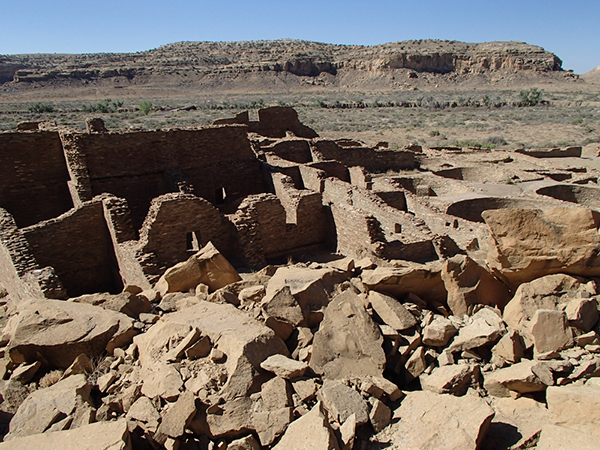
by Rossie Izlar Thursday, January 12, 2017

Ruins of Great Houses built by ancestral Puebloans remain in Chaco Canyon. Credit: Kenneth Barnett Tankersley
The remains of elaborate stone houses, some with hundreds of rooms, and other structures scattered throughout New Mexico’s Chaco Canyon attest to advanced settlements built there by ancestral Puebloans between A.D. 800 and 1250. But how these peoples subsisted amid the arid climate and seemingly infertile ground of the canyon has long puzzled scientists. In a new study, researchers suggest that Chaco Canyon’s salty desert soils may have supported ample agriculture after all.
“Chaco Canyon doesn’t match areas we consider to be fertile,” says Adam Watson, an archaeologist at the American Museum of Natural History in New York and a co-author of the study, published in the Journal of Archeological Science: Reports. “So we’re left with this mystery of how it’s possible that people lived there.”
The new study touches on a decades-long debate: Were the ancient Puebloans able to support themselves for prolonged periods in Chaco Canyon by growing corn, or was the canyon only a pilgrimage site to which they carried enough food to last through each stay?
“The evolving model has been that Chaco Canyon wasn’t a rich agricultural site; that people just came here for ceremonies and brought corn with them on their backs,” says Vern Scarborough, an anthropologist at the University of Cincinnati and study co-author. “But we’re suggesting that this place might have been more productive than we thought.”
The researchers sampled soils at depths up to about 3.5 meters in areas of the canyon thought to show evidence of ancient irrigation. They analyzed the soil’s chemical and mineral composition to determine how suitable ancient soils were for agriculture, and also tested the mineral composition of three streams in the canyon to determine how they might have affected soils.
The researchers found that in many pockets of Chaco Canyon, salt levels in the soil are low enough to potentially allow for cultivation of crops like corn. They also observed that Chaco’s ancient soils contained a variety of mineral salts, some of which, like the sulfate salt gypsum, are beneficial to plant growth. In addition to boosting productivity in some cases, salts can also add to fertility by breaking up compacted soils and helping plants absorb nutrients, the team noted in the study.
The findings in the new research challenge conclusions from some previous research, including work done by Larry Benson, a senior scientist emeritus at the U.S. Geological Survey and his colleagues, who have concluded that Chaco’s soils were too salty for large-scale agriculture, suggesting that Chaco Canyon was likely used as a pilgrimage site without many full-time residents.
Benson’s team measured the total concentration of salts in Chaco’s soils, but did not differentiate types of salt. Regardless of type, Benson says, too much salt slows the rate at which plants absorb water from the soil and ultimately dehydrates them to death. “Soils along the valley are extremely salty,” he says. “It would take an extremely large rainfall to wash that salt away,” he says. “And Chaco Canyon is pathetic when it comes to rainfall.” The area receives just 22.6 centimeters of rain per year on average, roughly four times less than in corn-producing Illinois, for example. Benson, who addressed his concerns with the new study in a rebuttal published in the same journal, says there’s no evidence suggesting that the climate was significantly different in Chaco Canyon’s prime.
An extensive network of dams and shallow canals in the canyon shows that ancient people tried to capture intermittent rainfall to use for irrigation, although researchers have been unable to pinpoint exactly when these structures were built or who built them. Additionally, because natural waters, including rainwater, contain dissolved salts, irrigation can often make salty soils even more infertile, especially in dry areas without consistent rainfall to flush salts from soil. When water in the soil from irrigation evaporates, the salts are left behind and can accumulate, typically to the detriment of soil fertility.
But, according to Gwinn Vivian, a longtime Chaco Canyon researcher and former curator of archaeology at the Arizona State Museum, the ancient canal irrigation systems prove that ancestral Puebloans in Chaco produced enough food locally for themselves. “Why invest all that labor if you’re not going to get a large yield?” he asks. “These people were smart. There was definitely farming being done.”
Vivian says that location matters in the canyon when it comes to agriculture. For example, soils in the side valleys have lower levels of salt than those in the main valley. Ancient Puebloans could have relied on soils in these side valleys, as well as on water-management techniques, to grow enough corn.
But how much corn was enough? Benson says that if there were only a few hundred people living in Chaco at a time, the side valleys might have been able to support them without outside help. “But if there were more than a few hundred, then food would have had to be brought in,” he says. “There’s just not a lot of evidence showing that Chaco Canyon was a Garden of Eden.”
© 2008-2021. All rights reserved. Any copying, redistribution or retransmission of any of the contents of this service without the expressed written permission of the American Geosciences Institute is expressly prohibited. Click here for all copyright requests.